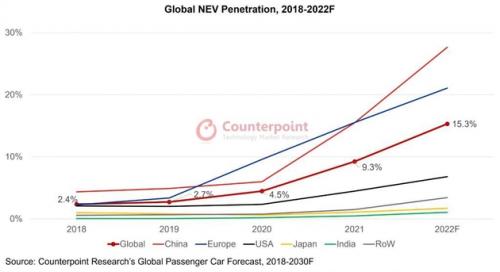your current location is:Home > TechnologyHomeTechnology
The U.S. semiconductor market has taken a sharp turn: the shortage of surplus and shortage is "unprecedented and strange"

according to reports, not long ago, the global semiconductor industry is facing soaring demand, as well as a chip supply crisis. However, with the passage of time, the days of the semiconductor industry have taken a turn for the worse, and analysts have said that they "can't understand".
Unprecedented complex situation
Historically, the semiconductor industry has experienced frequent cyclical demand fluctuations, but this time the changes are really complicated. Many researchers are currently scratching their heads: what kind of situation will the weakness of semiconductors this time be.
At present, in the fields of memory chips, personal computer processors and other chips, there is a rapid oversupply. However, at the same time, in the fields of automotive chips and industrial chips, semiconductor manufacturers have not been able to satisfy customers and establish a stable chip supply.
The sharp weakness this time around has prompted several U.S. semiconductor giants to cut billions of dollars in capital spending plans.
Dan Hutcheson, CEO of VLSI Research, a semiconductor industry research firm, has been studying the chip industry since the 1980s and is a veteran semiconductor watcher. Hutcheson said that the sharp turnaround in the semiconductor market this time, as well as various contradictory forces exerted on the market, is unprecedented.
Hutchison said he has never seen a situation where the semiconductor market is in short supply on one side and a large inventory of chips on the other.
According to an analysis by VLSI Research, the immediate cause of the weakness this time around is the massive build-up of inventories in the semiconductor supply chain from the beginning of the year. For example, in February, semiconductor manufacturers' inventory of chips can support 1.2 months of downstream production consumption. In June, the global inventory increased to the equivalent of 1.4 months of consumption, and it increased to 1.7 months in July.
If there is a deeper cause of the industry downturn, it should be that consumers are tight on their wallets, and global sales of PCs and smartphones have shrunk sharply.
Manufacturers in many industries around the world have been building up chip inventories in order to secure supplies in the event of another supply crisis in the future. However, these manufacturers have also made a U-turn as the market fears an economic slowdown or even a recession.
Due to complex factors, in the current weak semiconductor market, it is difficult to analyze whether it is due to ongoing supply chain problems or the collapse in demand from downstream customers.
Earliest signal in July
The earliest signs of weak demand this time around came in July. At that time, the US semiconductor giant Intel announced a piece of news that shocked Wall Street analysts: Intel's operating income in the second quarter was 2.6 billion US dollars, 15% less than analysts' expectations.
Intel CEO Pat Gelsinger (Pat Gelsinger) said the poor performance was due to a "once in a decade" inventory adjustment in the semiconductor industry, as well as Intel's own operating problems.
Nvidia last week forecast a performance message that sales of gaming chips would plummet 44% from the previous quarter. The company mainly produces graphics processors, which are used in video equipment or artificial intelligence machine learning systems.
Micron Technology is one of the world's major memory chip manufacturers. Free cash flow is likely to be negative in the coming quarter ($1 billion in free cash flow in recent quarters), the company said.
The pressure on the semiconductor market has also spread to the Asian market. A month ago, Taiwanese semiconductor foundry giant TSMC said it expected an inventory adjustment in the chip industry that would last into next year.
Giants cut capital spending
In the past, many semiconductor companies in the U.S. planned to expand their local production facilities, but the market downturn has forced them to reconsider their expansion plans.
Intel announced that capital expenditures for the remainder of the year will be reduced by $4 billion. However, the company still promised to give shareholders a "strongly growing dividend."
Micron Technology once said that it will invest $40 billion in the United States by 2030. But then, the company corrected itself, saying it would make massive capital spending cuts next year due to weaker markets.
For now, most semiconductor experts predict that the weakness this time around will not be much, as the global economy in general is heading for a soft landing. However, drastic changes in some market elements have forced these experts to ponder the complexities of interacting elements.
Technology market research firm Gartner has predicted that the growth rate of the global semiconductor market was 26% last year, and this year's growth rate will be cut in half. The company later revised the growth rate to 7%. For next year, Gartner sees the global chip market shrinking by 2.5% to $623 billion.
Wall Street's reaction is a little weird
Wall Street's reaction to the chip industry's weakness has been relatively stoic. The famous "Philadelphia Semiconductor Index" (which includes 30 major companies in semiconductor design, manufacturing, and sales) has fallen by about 40% this year, but it should be pointed out that after soaring during the epidemic, the US stock market has basically adjusted this year. .
Surprisingly, the semiconductor industry was already showing signs of weakness in early July, but the Philadelphia Semiconductor Index has rebounded 24% since then.
On Monday, Nvidia stock bounced back to where it was before the dismal earnings report. According to the financial report, Nvidia’s actual revenue was 17% lower than its previous forecast.
Weakness is widening
Over the past two years, the semiconductor industry has seen severe inventory followed by a shortage of supply. Many analysts have been afraid to judge how the economic slowdown will affect the semiconductor industry as confidently as in the past. Some analysts had hoped that the decline in semiconductors would be concentrated in PCs and smartphones, but that hope has been crushed by reality.
Nvidia's poor performance is mainly due to the sharp drop in the game chip market. It should also be noted, however, that the company's data center processors grew only 1% quarter-on-quarter, compared with Wall Street analysts' expectations for a 10% increase. Nvidia's analysis said that the biggest impact on the company's data center processors is the lack of supply rather than the collapse in demand. However, combined with Intel's data, there is a view that the once fast-growing global cloud computing market (downstream customers of data center processors) is now cooling down.
In recent days, there have been signs that the weakness in semiconductors is widening. Industrial companies and automakers have become the latest customers to cut chip orders, said Mark Murphy, Micron's chief financial officer.
Murphy said this is the latest change in industry demand. However, Micron Technology has not yet been able to determine whether these customers have adjusted because the previous purchase volume was too high, or whether they were forced to reduce orders because of the decline in demand from their own downstream customers.
In either case, Murphy said, the results are the same for Micron. "We're seeing clear signs of weaker demand in these markets."
Previous:Elon Musk: Tesla humanoid robots will be cheaper than cars for both industrial and domestic use
Next:Australia's Supreme Court: Google's link to controversial article is not suspected of defamation
related articles
Article Comments (0)
- This article has not received comments yet, hurry up and grab the first frame~













